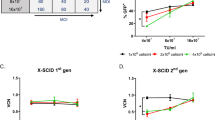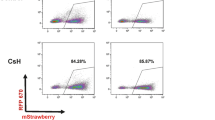Abstract
Autologous bone marrow transplantation is an alternative therapeutic option for acute myeloid leukemia patients lacking a compatible donor. However, bone marrow from these patients may contain residual leukemic cells that should be ideally eliminated prior to the infusion of the graft. With the aim of developing more efficient protocols of graft purging, adenoviral-mediated gene transfer protocols have been conducted. We studied whether suicide adenoviral vectors expressing the cytosine deaminase gene (AdCD) could be used for selectively killing leukemic WEHI-3B cells. The AdCD transduction followed by the 5-fluorocytosine exposure abrogated the growth of WEHI-3B cells in vitro, with a minimal effect on normal hematopietic progenitors. To test the efficacy of the purging protocol in vivo, bone marrow cells were mixed with syngenic WEHI-3B cells and this chimeric cell population was transduced with AdCD vectors. Infected cells were injected into myeloablated Balb-c mice, which then received a 5-fluorocytosine treatment for 4 days. All mice transplanted with unpurged bone marrow developed leukemia and died. However, 90% of recipients receiving the purging treatment were healthy up to 9 months post-transplantation and had a perfectly re-established hematopoietic system, without any signal of leukemic cell presence. In conclusion, suicide adenoviral vectors are proposed as a tool for the purging of Adenoviral-susceptible myeloid leukemia cells contaminating autologous bone marrow grafts.
This is a preview of subscription content, access via your institution
Access options
Subscribe to this journal
Receive 12 print issues and online access
$259.00 per year
only $21.58 per issue
Buy this article
- Purchase on Springer Link
- Instant access to full article PDF
Prices may be subject to local taxes which are calculated during checkout







Similar content being viewed by others
References
Burnett AK, Kell J, Rowntree C . Acute myeloid leukemia: therapeutic indications. Curr Opin Hematol 2000; 7: 333–338.
Kanda Y, Miwa A, Togawa A . Treatment of acute myeloid leukemia. N Engl J Med 1999; 340: 1436.
Brenner MK et al. Gene marking to determine whether autologous marrow infusion restores long-term haemopoiesis in cancer patients. Lancet 1993; 342: 1134–1137.
Deisseroth AB et al. Genetic marking shows that Ph+ cells present in autologous transplants of chronic myelogenous leukemia (CML) contribute to relapse after autologous bone marrow in CML. Blood 1994; 83: 3068–3076.
Rill DR et al. Direct demonstration that autologous bone marrow transplantation for solid tumors can return a multiplicity of tumorigenic cells. Blood 1994; 84: 380–383.
Laporte JP et al. One hundred twenty-five adult patients with primary acute leukemia autografted with marrow purged by mafosfamide: a 10-year single institution experience. Blood 1994; 84: 3810–3818.
Gorin NC . Marrow purging for autologous bone marrow transplantation and its role in acute myelocytic leukemia. European Cooperative Group for Bone Marrow Transplantation (EBMT). Leukemia 1992; 6: 96–101.
Rowley SD et al. CFU-GM content of bone marrow graft correlates with time to hematologic reconstitution following autologous bone marrow transplantation with 4-hydroperoxycyclophosphamide-purged bone marrow. Blood 1987; 70: 271–275.
Visani G et al. Cryopreserved autologous bone marrow transplantation in patients with acute nonlymphoid leukemia: chemotherapy before harvesting is the main factor in delaying hematological recovery. Cryobiology 1990; 27: 103–106.
Davies FE et al. Positive and negative selection to reduce tumour contamination in peripheral blood stem cell harvests. Hematol Oncol 2000; 18: 111–120.
Humpe A et al. Successful transplantation and engraftment of peripheral blood stem cells after cryopreservation, positive and negative purging procedures, and a second cryopreservation cycle. Ann Hematol 2001; 80: 109–112.
Berenson RJ et al. Transplantation of CD34+ hematopoietic progenitor cells. Cancer Invest 1996; 14: 589–596.
Kanz L, Brugger W, Scheding S . Ex vivo manipulation of hematopoietic stem and progenitor cells. Stem Cells 1998; 16: 199–204.
Sperling C et al. CD34 expression in de novo acute myeloid leukaemia. Br J Haematol 1993; 85: 635–637.
Clarke MF et al. A recombinant bcl-x s adenovirus selectively induces apoptosis in cancer cells but not in normal bone marrow cells. Proc Natl Acad Sci USA 1995; 92: 11024–11028.
Chen L et al. Selective transgene expression for detection and elimination of contaminating carcinoma cells in hematopoietic stem cell sources. J Clin Invest 1996; 98: 2539–2548.
Seth P et al. Adenovirus-mediated gene transfer to human breast tumor cells: an approach for cancer gene therapy and bone marrow purging. Cancer Res 1996; 56: 1346–1351.
Garcia-Sanchez F et al. Cytosine deaminase adenoviral vector and 5-fluorocytosine selectively reduce breast cancer cells 1 million-fold when they contaminate hematopoietic cells: a potential purging method for autologous transplantation. Blood 1998; 92: 672–682.
Lillo R et al. Efficient and non toxic adenoviral purging method for autologous transplantation in breast cancer patients. Cancer Res 2002; 62: 5013–5018.
Garcia-Castro J et al. Selective transduction of murine myelomonocytic leukemia cells (WEHI-3B) with regular and RGD-adenoviral vectors. Mol Ther 2001; 3: 70–77.
Garcia-Castro J, Segovia JC, Bueren JA . Transplantation of syngenic bone marrow contaminated with NGFr-marked WEHI-3B cells: an improved model of leukemia relapse in mice. Leukemia 2000; 14: 457–465.
Selvaggi KJ et al. Improved outcome for high-risk acute myeloid leukemia patients using autologous bone marrow transplantation and monoclonal antibody-purged bone marrow. Blood 1994; 83: 1698–1705.
Gorin NC . Autologous stem cell transplantation in acute myelocytic leukemia. Blood 1998; 92: 1073–1090.
Reiffers J et al. Autologous blood cell vs marrow transplantation for acute myeloid leukemia in complete remission: an EBMT retrospective analysis. Bone Marrow Transplant 2000; 25: 1115–1119.
Rizzoli V, Carlo-Stella C . Stem cell purging: an intriguing dilemma. Exp Hematol 1995; 23: 296–302.
Vescio R, Berenson J . Autologous transplantation. Purging and the impact of minimal residual disease. Hematol Oncol Clin North Am 1999; 13: 969–986.
Mullen CA, Kilstrup M, Blaese RM . Transfer of the bacterial gene for cytosine deaminase to mammalian cells confers lethal sensitivity to 5-fluorocytosine: a negative selection system. Proc Natl Acad Sci USA 1992; 89: 33–37.
Austin EA, Huber BE . A first step in the development of gene therapy for colorectal carcinoma: cloning, sequencing, and expression of Escherichia coli cytosine deaminase. Mol Pharmacol 1993; 43: 380–387.
Ghannoum MA, Rice LB . Antifungal agents: mode of action, mechanisms of resistance, and correlation of these mechanisms with bacterial resistance. Clin Microbiol Rev 1999; 12: 501–517.
Taguchi T . Clinical application of biochemical modulation in cancer chemotherapy: biochemical modulation for 5-FU. Oncology 1997; 54: 12–18.
Yasukawa M et al. Human herpervirus infection of lymphoid and myeloid cell lines transduced with an adenovirus vector containig the CD4 gene. J Virol 1997; 71: 1708–1712.
Koizumi N et al. Efficient gene transfer by fiber-mutant adenoviral vectors containig RGD peptide. Biochim Biophys Acta 2001; 1568: 13–20.
Segerman A, Mei Y-F, Wadell G . Adenovirus type 11p and 35p show high binding efficiencies for committed hematopoitic cell lines and are infective to these cell lines. J Virol 2000; 74: 1457–1467.
Cantwell MJ, Sharma S, Friedmann T, Kipps TJ . Adenovirus vector infection of chronic lymphocytic leukemia B cells. Blood 1996; 88: 4676–4683.
Huang MR et al. Efficient adenovirus-mediated gene transduction of normal and leukemic hematopoietic cells. Gene Therapy 1997; 4: 1093–1099.
Meeker TC et al. Adenoviral vectors efficiently target cell lines derived from selected lymphocytic malignancies, including anaplastic large cell lymphoma and Hodgkin's disease. Clin Cancer Res 1997; 3: 357–364.
Roddie PH, Paterson T, Turner ML . Gene transfer to primary acute myeloid leukaemia blasts and myeloid leukaemia cell lines. Cytokines Cell Mol Ther 2000; 6: 127–134.
Gonzalez R et al. Increased gene transfer in acute myeloid leukemic cells by an adenovirus vector containing a modified fiber protein. Gene Therapy 1999; 6: 314–320.
Schwarzenberger P et al. Poly-L-lysine-based molecular conjugate vectors: a high efficiency gene transfer system for human progenitor and leukemia cells. Am J Med Sci 2001; 321: 129–136.
Ebbinghaus C et al. Functional and selective targeting of adenovirus to high-affinity Fcγ receptor I-positive cells by using a bispecific hybrid adapter. J Virol 2001; 75: 480–489.
Gonzalez R et al. Transduction of bone marrow cells by the AdZ.F(pK7) modified adenovirus demonstrates preferential gene transfer in myeloma cells. Hum Gene Ther 1999; 10: 2709–2717.
Howard DS et al. Genetic manipulation of primitive leukemic and normal hematopoietic cells using a novel method of adenovirus-mediated gene transfer. Leukemia 1999; 13: 1608–1616.
Neering SJ et al. Transduction of primitive human hematopoietic cells with recombinant adenovirus vectors. Blood 1996; 88: 1147–1155.
Watanabe T et al. Gene transfer into human bone marrow hematopoietic cells mediated by adenovirus vectors. Blood 1996; 87: 5032–5039.
Heyworth CM, Spooncer E . In vitro clonal assays for murine multipotential and lineage restricted myeloid progenitor cells. In: Haemopoiesis: A Practical Approach Testa N, Molineaux G (eds). IRL Press: New York, NY, 1993, pp 36–53.
Lamar EE, Palmer E . Y-encoded, species-specific DNA in mice: evidence that the Y chromosome exists in two polymorphic forms in inbred strains. Cell 1984; 37: 171–177.
Acknowledgements
We thank I Ormán for expert assistance with the flow cytometry analysis, and S García, E López and J Martínez for excellent technical assistance. Supported by grants from Comisión Interministerial de Ciencia y Tecnología (CICYT; SAF98-C04-C01). JG-C was supported by grants from Programa de Formación de Personal Investigador (Ref. PN95 05413749) -CICYT- and Instituto de Estudios de la Energía, CIEMAT.
Author information
Authors and Affiliations
Rights and permissions
About this article
Cite this article
Garcia-Castro, J., Rio, P., Lillo, R. et al. Purging of leukemia-contaminated bone marrow grafts using suicide adenoviral vectors: an in vivo murine experimental model. Gene Ther 10, 1328–1335 (2003). https://doi.org/10.1038/sj.gt.3301993
Received:
Accepted:
Published:
Issue Date:
DOI: https://doi.org/10.1038/sj.gt.3301993
Keywords
This article is cited by
-
A Generic Research Paradigm for Identification and Validation of Early Molecular Diagnostics and New Therapeutics in Common Disorders
Molecular Diagnosis & Therapy (2007)
-
Purging of murine erythroblastic leukemia by ZnPcS2P2-based-photodynamic therapy
Bone Marrow Transplantation (2006)



